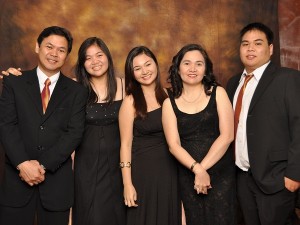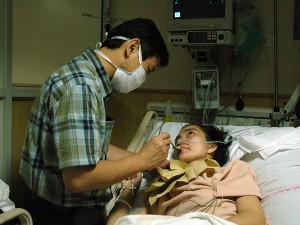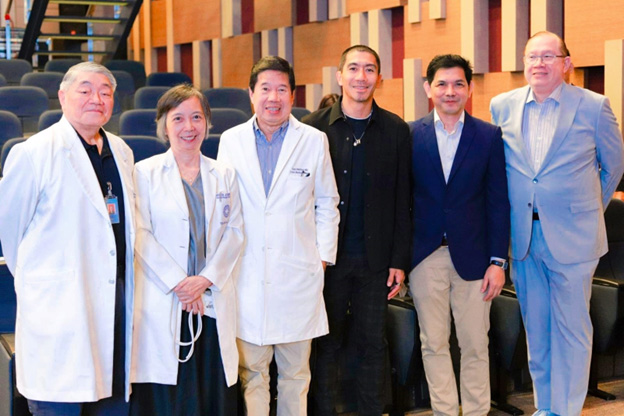He didn’t have any money in his wallet on their first official date. He had invited her to the restaurant to celebrate his birthday—but as things turned out, she ended up paying for their meal. In terms of romantic etiquette, that was nothing less than a disaster.
And yet, it was this same guy, Chet Espino, who would spend 88 days in India caring for that same woman who paid for their meal—now his wife, Margie—after she suffered two aneurysms during her official trip there. Chet and Margie’s story is truly inspiring in both the romantic and spiritual sense. Their story is told in detail in the book “88 Days in India: A Pilgrimage of Faith, Hope and Love”; the book’s nearly 200-page length is a compilation of Chet’s daily e-mail updates, sent to members of an e-group created by her friends. The e-group served as a support network of prayers and wishes for Margie’s healing. It was a book that, as Chet says, had practically written itself.
The couple’s life-changing ordeal happened in November 2008 when Margie, as Business Features Editor of the Philippine Daily Inquirer, was invited by a private firm to cover the company’s corporate social responsibility awards ceremony. What was supposed to have been a four-day business trip turned for the worst when, during a trip through Faridabad, industrial district of the Indian state of Haryana—about an hour from the nation’s capital, New Delhi—Margie was stricken with an aneurysm.
The company flew Chet to India on November 29th, where he finally joined his wife in the hospital. It was a desolate and frightening time for Chet, who had no clear idea of his wife’s condition, or even if she would still be alive once he found her in the hospital. He writes in the book:
“The 11-hour trip to New Delhi, including a lonely, five-hour layover at Singapore airport, was very frightening. There was always the fear of not knowing if I was going to find Margie alive in India… The bumpy ride from the airport to the hospital in Haryanna district was eerie. The haze formed by mist and dust that enveloped India let me know all the more I was indeed in extremely unfamiliar territory.
“Within an hour we arrived at the hospital in Faridabad. My heart beat faster as we made our way through the corridors and into the intensive care unit. Margie, my beloved wife of 17 years, mother of our three children, whom I kissed goodbye just days ago when I brought her to the airport in Manila, was there all right.
“She was in coma.”
Chet watched over and took care of Margie there for 20 days, until the time when it became urgently necessary for her to be moved to another hospital in New Delhi; it was the best facility available to treat her condition, which had become critical.
For more than three months while Margie was under the care of Indian doctors in New Delhi, it was an emotional roller-coaster ride for Chet and his teenaged kids who were left in the Philippines to fend for themselves while their parents were in India. Margie went through two aneurysms and had to survive further complications including hydrocephalous, meningitis, bedsores and bouts of infections.
Margie showed signs of recovery at one point, only for her to be confined in the ICU yet again when a second aneurysm struck, causing her brain to bleed. After she shook off, miraculously, the major clinical events that occurred, she still had to recover her normal brain functions. There were times when her brain could not process what her eyes were seeing. She’d lost most of her memory, even forgetting Chet himself. She told him at one point, “I’m a married woman.”
It was indeed a great struggle for Chet, Margie, her family and friends, until the day when she finally returned to the Philippines on February 26, 2009. It was a homecoming that was also still the beginning of more recovery, a slow resurrection back into the fold of her loved ones. She still couldn’t walk. She had to re-learn normal human functions, which meant painful physical therapy sessions.
“I used to wonder why we need to have a health card, but now, I’m using Medicard. Medicard has been taking care a lot of our medical bills. It’s good we have a health card now,” said Margie, who is still undergoing physicaly therapy and other treatments. Her recovery is ongoing, although the degree to which she has regained her health and functioning is just amazing.
The president of Medicard, Dr.Nicky Montoya, even visited Margie a few times at the hospital here in the Philippines. Chet and Margie recalled that they never knew he was actually the president of Medicard because he never introduced himself as such. It was only much later, to their surprise, that they found out that Dr. Montoya was not merely a representative of the HMO.
A deeper love
Fast forward to 2012. Margie is back at work, editing the Business Features section of the Philippine Daily Inquirer. She is still recovering—a fact that is made noticeable by a gimp in her left leg. Margie, however, is every inch a living, walking miracle. A recipient, according to her and Chet, of God’s miraculous providence—it was really God that pulled them through and restored Margie back to an amazing life.
Margie says that her love for Chet has grown deeper with the knowledge of how much he struggled to help her recover. Chet, on the other hand, says that he came away from the experience with the insight that in a marriage “it’s really not about what you can get from your spouse in the marriage; it’s about how much you can give your husband or your wife, and how you can keep on giving.”
It’s touching to hear them recount their story, three years after their experience in India—even when they joke about the times when Chet was courting her. She and Chet revealed that their courtship phase was marked by what could be described as a comedy of errors—mostly because of Chet.
Filipinos can learn a lot from the story of Chet and Margie, a story that is best told in Chet’s book. It’s a story of how a husband, who once couldn’t pay for his wife-to-be’s meal, was able to “love her back to life” as one writer put it. It’s a story of how God works miracles in His own inscrutable way, to show us a model of true faith.
Inspiring medical care
The humorous anecdotes make the love story between Chet and Margie more human, more touching and more real. But there’s another story—besides the story of their faith and the story of their love—that one reads as a subtext in “88 Days in India: A Pilgrimage of Faith, Love and Hope”: it’s the story of how providential it was that Margie’s illness happened when she was in India.
Many of those who were receiving updates from Chet while he was with Margie in India were probably surprised at the quality of medical care that she was receiving. While the Indian healthcare system has been recognized as one of the best in the world for many years now, it’s still different to see it from Chet’s perspective. Chet gives a grateful account of the competence and concern displayed by the Indian doctors and medical staff. Margie’s first neurosurgeon in that hospital in Faridabad was the pillar on whom Chet relied on for strength and hope when it came to her medical treatment. And yet, even the doctor had to admit that he no longer knew what to do next, when Margie had a second bout of bleeding when a second aneurysm struck.
Chet was very resistant of the suggestion that Margie be moved to the hospital in Delhi, fearing that a transfer would endanger her more. He only agreed after he had a husband-to-husband talk with the doctor. Chet asked the doctor, “If your wife was in my wife’s place, would you transfer your wife to this other hospital?” When the doctor said yes, Chet consented to the transfer.
The medical team took care of Margie in the hospital in New Delhi. It was at that hospital that Margie recovered from her complications and where she became well enough to be fit to travel back to the Philippines.
Learning from India
According to Chet, what struck him most was how the Indian doctors treated patients with a spirit of humble service. He explained that the Indian doctors who attended to them put on no airs, and even drove modest car models. And of course, Chet believes that the expertise of Indian medical care, along with faith prayers and God’s providence, was a big factor in Margie’s recovery.
Chet also mentioned that doctors in India are very aware that word of mouth about how they treat patients will impact the reputation of Indian medical care, and so they always strive to do their best—especially since India is now a hub for global healthcare travel or medical tourism.
So Chet’s book is also, in its own way, a story of how important it is for any nation to bring its healthcare up to excellent standards. Indian medical care took off to a new level when the government worked with private and public healthcare providers to raise and meet world-class standards. In India, this is done through accreditation with the National Accreditation Board for Hospitals and Healthcare providers or NABH, which is one of the international accrediting bodies under the ISQua (International Society for Quality in Healthcare) just like JCI and others.
“It was the story of Chet and Margie that made us realize how good healthcare in India really is,” said Joyce Alumno, Executive Director of HealthCORE, a think tank for research in global health travel and now the country representative of NABH International.
According to Joyce, she was advocating along with DOT and DOH the quality of medical care in the Philippines for years, only to be awe-struck by the story of Chet and Margie’s experience in India.
“When I heard the story of Chet and Margie, I was very humbled upon realizing that, while the Philippines has very good doctors, nurses and other medical staff, our own healthcare system still has a lot to learn from Indian medical care,” said Joyce. She cited the fact that Margie was given first aid in a small lying in clinic in Fadirabad as an example.
“Margie and her companions were desperately pooling money in order to pay the clinic. They ended up paying only P6,000 all in all, and the clinic even gave them a bagful of medicines for Margie to use, which was good for few months’ supply. The incredible thing is, even a small lying in clinic in India is competent enough to give initial emergency to someone like Margie, who suffered from a potentially fatal aneurysm. That says a lot about the high degree of healthcare quality in India.
“If the lying clinic didn’t have the competence, then they would have failed in the initial emergency care of Margie—and who knows what could have happened. And they were able to help save her life—only at a cost of P6,000. Imagine if we could do the same thing here? Imagine what would happen if even small Philippine clinics gained the competence to provide quality care in potentially life-threatening illnesses—and at lower cost. If we could do the same thing, all Filipinos would benefit, especially the poor,” said Joyce.
The story of Chet and Margie inspired Joyce to go into talks with NABH of India to ask them to assist the Philippines learn from India’s healthcare system. These talks resulted in HealthCORE becoming the official Philippine representative of NABH.
Currently, NABH is working with HealthCORE in providing seminars and workshops to Philippine healthcare providers, to help them begin the process of upgrading the quality of their operations and services to become world-class like India’s. Philippine healthcare providers who attend these HealthCORE seminars and workshops also have the option to apply for international accreditation through NABH International, the global accreditation arm of NABH.
As Chet mentioned during this interview, “In life, there are no accidents.” So there may be readers out there who are encountering Chet and Margie’s story for the first time, or those who may have heard about it in passing. Well, it could be that Providence is leading them to a path towards renewed faith or simply to a source of inspiration in loving and living. In that case, it would be a good idea to get a copy of Chet’s book, which is a love story that we all need to hear about.
xxx
ROYAL TREATMENT
It’s not everyday that a Philippine hospital treats royalty, but that’s what happened when Iso Nanhken Iriarte and his wife Nahnkeniei, leaders of the kingdom of Pohnpei of the Federated States of Micronesia (FSM) went to the Philippine Heart Center. Iso’s wife needed to have some diagnostic procedures done on her heart and they chose to go to the Philippine Heart Center.
Nahnkeniei’s non-royal, birth name is Ruth Iriarte and she is a Vice-President of the Bank of FSM. She gladly shared her experience as a patient at the Philippine Heart Center. She said that it was okay for Filipinos to call her by her birth name—but in Pohnpei, calling her by that would be a disrespect to her status.
“We chose to go to the Philippine Heart Center because of its expertise. Also, during my stay here, I feel very much that the doctors and nurses here really care for me. I feel safe,” said Ruth.
She said that there was a suggestion for her to go to a medical facility in China. However, she preferred to go to the Philippines for several reasons.
“First of all, Chinese culture is very different from that of Pohnpei and the other islands in Micronesia. Our culture and that of the Philippines are very similar. Also, Filipinos speak English very well,” she said. Pohnpei, Ruth explained, is a territory under the administration of the United States and the currency there is the U.S. dollar. This means that she and her husband are able to change their dollars to pesos in the Philippines.
Her husband, Iso Nahnken, said that the exchange rate between the two currencies lowers the cost of their travel and medical care in the Philippines.
Ruth is very appreciative of how the doctors, nurses and other medical staff treated her. “They treat me very well. They are very friendly, very caring. I feel cured! I can feel their emotions, I see that they care. To me, having that kind of relationship is very important.”
Iso Nahnken echoed Ruth’s sentiment. “In FSM, there are Filipino doctors and they also check on us. They were the ones who recommended that we go to the Philippine Heart Center.”
The royal couple also found their hospital room comfortable enough for both of them to stay there instead of a hotel. “I find it very comfortable and safe. I like it better here than in a hotel,” said Ruth.
Iso added that he found staying at the hospital very convenient. “The accommodations are all right. The space is big enough for us to stay in. It’s easy to get whatever we need right here at the hospital,” he said.
The even shared a very interesting story about the Philippine Heart Center involving Iso’s brother. According to them, Iso’s brother went through cardiovascular surgery ten years ago at the Philippine Heart Center. The brother was extremely pleased at how his Filipino cardiologist and surgeon attended to them.
“My brother felt that his cardiologist and the rest of the medical staff at the Philippine Heart Center treated them like family. He felt that his doctor was not only treating them as patients—he said that he was practically a parent to him when he was here.
“The doctor operated on my brother on the same day that his son was born. And so, when the baby was born, they named the baby after the surgeon. That boy is now ten years old, and his name is Charleson, named after the doctor,” Iso revealed.
Filipinos first
According to Dr. Gerardo Manzo, the Philippine Heart Center’s Assistant Director for Medical Services, the Philippine Heart Center treats about 350 to 450 foreign patients a year—a small number compared to the 13,000 Filipino patients that the facility is able to treat on an annual basis. However, he said that the PHC would not mind being able to treat more foreign patients, since this still benefits their facility’s Filipino patients.
“That is where we try to balance things. Whatever subsidy the Heart Center gets from government, all of it automatically goes to the charity wards, to be spent on the patients there. The rest of whatever revenues the hospitals gets is spent on salaries, operations and maintenance costs.
Now, whatever extra earnings the hospital receives–from medical tourism, for example–also goes to the Filipino patients in our charity wards. So in the end, our Filipino patients are still the ones that benefit.
“So, if we were to send a message to foreign patients, it would be that if they go for treatment at the Philippine Heart Center, they would be receiving quality, compassionate and patient-focused care from an internationally accredited, world-class cardiovascular facility—and at the same time, they would also be able to help Filipino patients of limited means to receive the same type of care. That’s a good thing—the ones that can afford medical care are able to help those with lesser means,” Dr. Manzo explained.
He added that the Philippine Heart Center does not charge separate rates for foreign patients and Filipino patients. Both groups are charged the same rates, and these rates are published in the hospital’s website at www.phc.gov.ph.
And yet, the Philippine Heart Center has not been actively marketing itself as a world-class cardiovascular facility, which is exactly what it is by now after it was awarded a Gold Certification from Accreditation Canada International in August 2011. The accreditation, according to Manzo, was not done for foreign patients—it was sought primarily to ensure the quality of the Philippine Heart Center’s service to Filipinos.
“Let me make it clear that the Philippine Heart Center is here primarily to provide medical care to Filipinos. All of the improvements we’ve made to bring to world-class levels the quality of our facilities, equipment, medical and surgical treatments, operations and services have been done–and will continue to be done–to benefit Filipino patients. Now, if foreign patients wish to come to us for treatment, then we will admit them because we are sure that we would be able to treat them here,” he said.
Recently, the Philippine Heart Center acquired the very first Lighting Room in its ICU; it is the very first in Asia and only the second in the world. The Lighting Room has its lights operated by software that follows the human circadian rhythm, which aids in treating patients by making sure their natural rhythms of rest and recovery are maintained.
The Philippine Heart Center will have, by mid-2012, the first and only Hybrid Operating Room in the Philippines and the third in Asia. A Hybrid OR is a highly-advanced and complex working environment for large teams of surgeons, nurses, anesthesiologists and technicians. The Hybrid OR allows all the members of the medical team to work efficiently and seamlessly together, which greatly increases the success of the surgery for the patient.
Dr. Manzo said that the Philippine Heart Center currently has 382 rooms and will soon be expanding to 450 rooms. “We want people to know that the Philippine Heart Center is always doing its utmost to continually upgrade its facilities and services, in order to serve our patients better. This is our lifelong commitment.” he said.










































